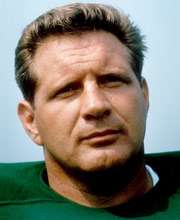Jim Ringo
|
circa 1966 | |||||||||
| No. 51, 54 | |||||||||
|---|---|---|---|---|---|---|---|---|---|
| Position: | Center | ||||||||
| Personal information | |||||||||
| Date of birth: | November 21, 1931 | ||||||||
| Place of birth: | Orange, New Jersey | ||||||||
| Date of death: | November 19, 2007 (aged 75) | ||||||||
| Place of death: | Virginia Beach, Virginia | ||||||||
| Height: | 6 ft 1 in (1.85 m) | ||||||||
| Weight: | 232 lb (105 kg) | ||||||||
| Career information | |||||||||
| High school: | Phillipsburg (NJ) | ||||||||
| College: | Syracuse | ||||||||
| NFL Draft: | 1953 / Round: 7 / Pick: 79 | ||||||||
| Career history | |||||||||
| |||||||||
| Career highlights and awards | |||||||||
| |||||||||
| Career NFL statistics | |||||||||
| |||||||||
| Player stats at PFR | |||||||||
James Stephen Ringo[4] (November 21, 1931 – November 19, 2007) was a professional American football player, a Hall of Fame center and coach. He was a ten-time Pro Bowler during his career.[1][5]
Early years
Born in Orange, New Jersey, Ringo grew up in Phillipsburg[6] and played high school football at Phillipsburg High School,[7] and college football at Syracuse University in Syracuse, New York.
Professional career
Green Bay Packers
The Packers selected him in the seventh round of the 1953 NFL draft out of Syracuse. Ringo was considered vastly undersized at 211 pounds (96 kg).
He was not, however, unfit for the role, using his outstanding quickness and excellent technique to build a 15-year NFL career, including 11 seasons with the Packers, as one of the game's best centers.
Ringo played for four different head coaches in his Packers tenure. In his first six seasons in Green Bay, playing under Gene Ronzani (1953), Lisle Blackbourn (1954–57) and Ray "Scooter" McLean (1958), the Packers went 20–50–2 (.286).
But Vince Lombardi's arrival in January 1959 changed everything, and for Ringo's next five seasons the Packers went 50–15–1 (.769) and 2–1 in championship games. Ringo certainly knew individual success before the Lombardi era, attending his first of seven straight Pro Bowls in 1957, but he flourished under the coaching legend, earning consensus All-Pro honors from 1959–63.
Ringo's speed and mobility made him an ideal blocker for Lombardi's famous power sweep, and all but one of running back Jim Taylor's five 1,000-yard seasons, including his then-record 1,474-yard effort in 1962, came with Ringo at center.
Philadelphia Eagles
Ringo was a member of the Packers' NFL Championship teams of 1961 and 1962, but was traded to the Philadelphia Eagles in 1964; the Packers went on to win an unprecedented three consecutive NFL championship games from 1965–67.
The details of Ringo's trade have been the subject of speculation. For years it was said that following the 1963 season, Ringo showed up in Lombardi's office, with an agent in tow, looking to negotiate a raise. Lombardi, according to this account, was so angered that he excused himself for five minutes only to return and announce that he had traded Ringo to the Eagles. Over the years it has been suggested that that story is more fiction than fact. In reality, Lombardi had probably been negotiating a trade for some time. The Packers also traded fullback Earl Gros and received in return linebacker Lee Roy Caffey and a first-round draft pick that they would eventually use to select halfback-punter Donny Anderson. Still, the legend persists. Ringo, who played 126 consecutive games for the Packers from 1954–63, finished out his career with the Philadelphia Eagles, attending three more Pro Bowls before retiring after the 1967 season.
Coaching
He went on to work on the coaching staffs of the Los Angeles Rams, Buffalo Bills (2 separate engagements), Chicago Bears, New England Patriots and New York Jets and served as Bills head coach after the resignation of Lou Saban in 1976, posting a 3–11 record. He is best known as a coach for creating the dominant Bills offensive line of the early-mid '70s, called the Electric Company, in support of running back O.J. Simpson. He returned to Buffalo as the Bills offensive coordinator and offensive line coach in 1985. He held the positions until his retirement after the 1988 season.
Ringo was inducted into the Pro Football Hall of Fame in 1981.
Death
Ringo died in Chesapeake, Virginia, on November 19, 2007 after a short illness.[8] He is buried at Fairmount Cemetery in his hometown of Phillipsburg.
References
- 1 2 "Jim Ringo's stats". pro-football-reference.com. Retrieved 2007-11-19.
- ↑ "NFL's 1960s All-Decade Team". www.nfl.com. Retrieved 2007-11-19.
- ↑ "Jim Ringo's coaching stats". Databasefootball.com. Retrieved 2007-11-19.
- ↑ "Jim Ringo's playing stats". Databasefootball.com. Retrieved 2007-11-19.
- ↑ Litsky, Frank (November 21, 2007). "Jim Ringo, Pro Football Hall of Fame center, dies at 75". New York Times. p. A25.
- ↑ Schudel, Matt. "NFL's Jim Ringo; Hall of Famer With Packers and Eagles", The Washington Post, November 22, 2007. Accessed March 14, 2011. "James S. Ringo Jr. was born Nov. 21, 1931, in Orange, N.J., and grew up in Phillipsburg, N.J."
- ↑ via Associated Press. "Phillipsburg grad, NFL great Jim Ringo dies at 75", The Star-Ledger, November 19, 2007. Accessed March 14, 2011. "Jim Ringo, who played for Phillipsburg High School before going on to a Hall of Fame career as a center for the Green Bay Packers and Philadelphia Eagles, died this morning after a short illness. He was two days shy of his 76th birthday."
- ↑ "Ringo dies at age 75". profootballhalloffame.com. Retrieved 2007-11-19.
External links
- Jim Ringo at the Pro Football Hall of Fame
- Career statistics and player information from NFL.com • Pro-Football-Reference • Databasefootball.com
- Jim Ringo at Find a Grave
